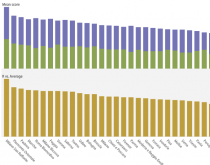
In questi dati vengono sintetizzati i 3 nodi essenziali del mondo accademico italiano, che rientrano ora in un contesto più internazionale dopo la conclusione del processo VQR2004-2010.
The conclusion of the evaluation process carried out by ANVUR highlighted some essential themes about the Italian academic world. For the first time in Italy, we have official data from a systematic evaluation of scientific production and other activities of Italian universities and research institutions.
Data reported in the table above are only referred to areas 5 (biology) and 6 (medicine), according to the CUN nomenclature adopted by ANVUR, thus leading to a ranking based on biomedical sciences, which produced the highest number of Top Italian Scientists and citations. In Italy, there are about forty universities with a complete school of medicine. Of these, two are private and position themselves in the first places of the ranking based on scientific production. On the other hand, this page shows the general ranking of all universities, based on the integrated index IRFS1 presented in the VQR revised report, which has been reworked and then compared with the Gran VIA ranking by Marco Geraci and me. This classification summarizes the main components behind Italian universities placement within international rankings: scientific prestige and national profile.
Scientific prestige is directly connected to the quality of scientific production and its accumulation through time. This is the reason why big, old universities like those of Rome, Milan and Bologna always place themselves amongst the first Italian institutions in international rankings. On the other hand, national profile depends from several national factors, particularly regarding students (quality of the services, chance to get a job once graduated, etc.) and society (technology transfer, counseling, local involvement, etc.).
Often, scientific prestige and national profile does not correspond, since the former requires time and critical academic mass that young universities lack, while they have new structures and are focused on some specific professional areas, which may prove to be helpful to get a high national profile. A consideration that, so far, counted for specialized universities like polytechnics and Bocconi, whose efficacy in bringing their graduates into the job market was not repaid by their placement, since they never appeared among the first ten Italian institutions within international rankings.
The global index IRFS1 used by VQR should consider both the components but basically favors young and/or specialized universities like Trento or the Polytechnic of Turin, which have no medicine courses. The table above is thus the first overview of the “biomedical” quality of Italian research institutions. It is only based on their scientific production, also because medicine graduates, as well as those in biomedical areas, do not have particular difficulties finding a job. VQR data offer an answer to the question “is it more prestigious to get a degree in Padua than in Rome?”
These data also highlight the expanding roles of new academic institutions within biomedical sciences like the exemplar case of the university of Catanzaro, which has a better placement that bigger and older universities like Pisa. And Catanzaro is not even the best one from southern universities, according to VQR data.
This reminds us of the importance of politics, not only in academic terms. Since building a new university depends from political choices, both local and national, now we know where such choices proved to be valiant in terms of biomedical research: Piemonte Orientale, Verona, Foggia, Ancona (with the polytechnic of the Marche), Catanzaro and Salerno. On the other hand, we also know which of these choices were not as much virtuous, like the splitting of Rome and Naples universities.
And what is the actual government – particularly the minister Maria Chiara Carrozza, first Top Italian Scientists to be leading MIUR – doing? When asked if she will have to close those universities at the bottom of VQR ranking, as it has been suggested, she answered “I don’t know”. Neither had she clarified when and how she will distribute the part of the national funding for universities that should be related – as she claimed – to VQR data. Thus far, the evaluation process started two years ago produced a lot of useful data but no practical consequences within the academic world. And this does not depend from academics, but from politicians.
Source: Via-Academy
The conclusion of the VQR2004-2010 evaluation process carried out by ANVUR highlighted some essential themes about the Italian academic world.
Realizzazione grafica: redazione Scienzainrete dai dati forniti dall'autore
fonte: Via-Academy
